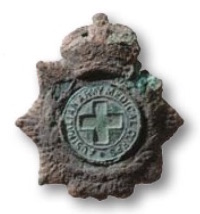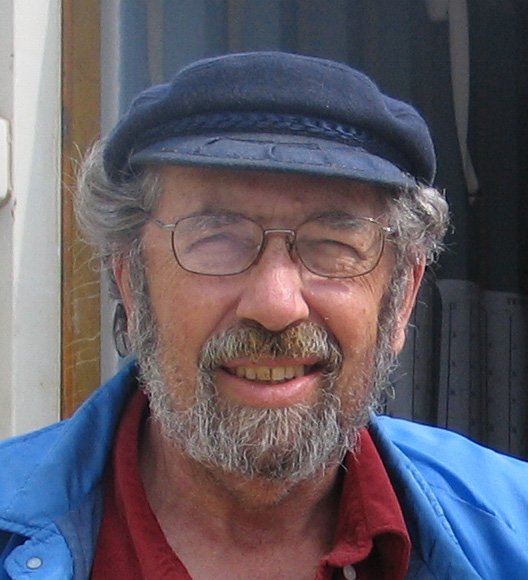A Baby, a Cradle, and a Torah that survived the Holocaust
People are the most valuable finds.

Australian Army Medical Corps Badge WWI
Although the Temple Mount Sifting Project focuses on ancient finds, many of the finds we retrieve are also from the modern era and we are studying them as well. This includes artifacts from World Wars I and II. But we always say that the most important finds are the people who volunteer to sift with us, and the staff with their special personalities and personal stories. On the occasion of Holocaust Memorial Day, Yom HaShoah, we would like to share with you the personal story of the project director Dr. Gabriel Barkay who was born in the Budapest ghetto a year before the end of the war, and a unique Torah scroll which was kept in his cradle.
I was born in 1944 on the same day my mother entered the ghetto, and she had two precious things: the newborn baby and the Torah scroll that was kept with the family. She dragged a large cart with all the things she could carry, and she gave birth to me. There had been horses used to tow the wagons, but because of the starvation in the community, they were all eaten in the weeks before, so there was neither food nor horses. My mother’s grandfather, Reb David Weiss, lived in a family home where several members of his family lived. He was a father of five children, four sons and a daughter who was my grandmother.
He had a private synagogue, and the Torah scroll was there in the synagogue. This Torah scroll was probably written in the 19th century in Romania. From Budapest, the Nazis hardly took Jews to the extermination camps. They planned to keep them hostage for the end of the war, though at the end of the war there were death marches from Budapest to Austria. Most of the people were killed on the way, and others went to concentration camps in Austria. Some died and some remained alive. But my family were probably forgotten in the back.
In November 1944, the Nazis took out all the inhabitants of the ghetto, including me, and took us to the train station, apparently to go to Poland. I do not know exactly what happened. Apparently, the train tracks were bombed and we were taken back to the ghetto and I was left behind. That is how I was saved, and also the Torah scroll that was hidden in my cradle.
- Bringing the Torah to the Synagogue
- The cover for the Aron Kodesh
After the war we went to Israel, I and the Torah scroll. In 2006 I was invited to a series of lectures in Canada. I met my mother’s cousin, who was then 91, but has since passed away. I told him that his grandfather’s Torah scroll was in my possession. He said, “Wait a minute,” and went into the other room and brought the curtain of the ארון קודש (holy ark) where the Torah scroll had been kept and gave it to me. This curtain was made around 1900. Hannah, wife of Reb David Weiss, embroidered it for his birthday. It is silver threads on velvet. The Torah was once used in my Bar Mitzvah in 1957. Afterward, we discovered that the Torah had mistakes and was invalid, so I made sure that it was fixed. The Torah underwent many hardships, was revised a few years ago, and then was re-inserted into my synagogue in East Talpiot in Jerusalem. -Dr. Gabriel Barkay
 Dr. Gabriel Barkay (73), the Jerusalem Prize laureate of archaeology, is considered by many to be the greatest expert on the archaeology of Jerusalem. He has excavated dozens of sites, and is known for his discovery of important silver scrolls from the First Temple period. As the blessing on the scrolls appear in the Torah, this is the oldest biblical text ever discovered. Barkay has taught for many years at Tel Aviv University, Bar Ilan University, and other institutions. He is a member of the Israel Antiquities Authority Advisory Council, and is an editor or consultant for several periodicals.
Dr. Gabriel Barkay (73), the Jerusalem Prize laureate of archaeology, is considered by many to be the greatest expert on the archaeology of Jerusalem. He has excavated dozens of sites, and is known for his discovery of important silver scrolls from the First Temple period. As the blessing on the scrolls appear in the Torah, this is the oldest biblical text ever discovered. Barkay has taught for many years at Tel Aviv University, Bar Ilan University, and other institutions. He is a member of the Israel Antiquities Authority Advisory Council, and is an editor or consultant for several periodicals.
Photo credit for the photographs from the ceremony bringing the Torah to the synagogue goes to Barry A. Kaplan.
Discover more from The Temple Mount Sifting Project
Subscribe to get the latest posts sent to your email.














Reblogged this on Kattukse Vrienden voor Israël.
A BEAUTIFUL story. Thank you for sharing. May God continue to Bless and Keep you.
Ginger Williamson